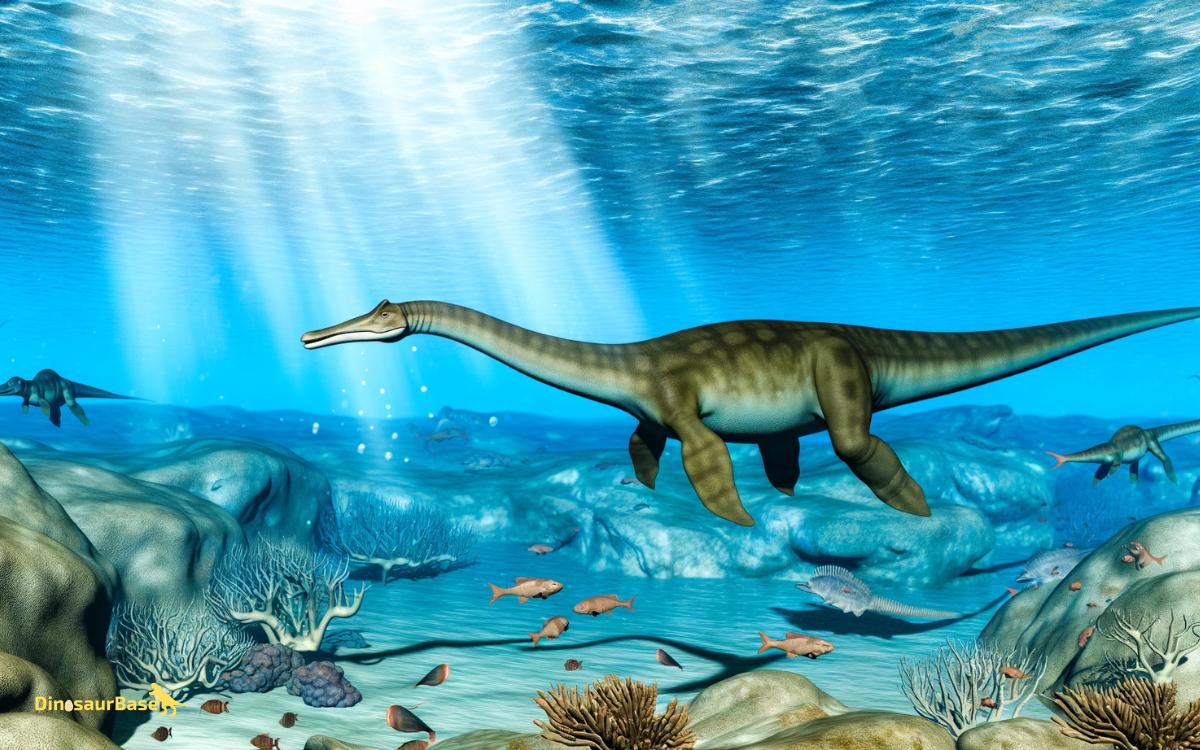Is Oil Dinosaur Blood? Unearth History Now!
In the quest for truth, the idea that the world’s oil reserves are merely the ‘lifeblood’ of ancient dinosaurs has captivated many.
However, professionals in geology and paleontology offer a more nuanced story about Earth’s ancient biomass and the complex processes that lead to the formation of petroleum.
They argue that it’s not just about dinosaurs but about the vast ecosystems of the past. As this discussion unfolds, one realizes that the intrigue lies not in simplifying these origins to a tale of prehistoric creatures but in understanding the intricate dance of natural history and science.
What might one learn from exploring the real story behind this myth?


Key Takeaway
The Myth Explored
The myth that crude oil originates from the remains of dinosaurs has permeated popular culture, yet lacks scientific backing.
Experts in geology and paleontology have clarified that crude oil, also known as petroleum, forms from the fossilized remains of ancient marine organisms, primarily zooplankton and algae, not dinosaurs.
These organisms settled in the vast, oxygen-poor mud at the bottom of seas or lakes millions of years ago. Over geological time, the layers of sediment and organic material underwent intense heat and pressure, transforming into the hydrocarbons that constitute crude oil.
This process, termed diagenesis followed by catagenesis, occurs over millions of years, indicating that the substance’s origins are far more ancient and complex than the simplistic notion of ‘dinosaur blood.’
What Is Petroleum?
Petroleum is a complex mixture of hydrocarbons that forms over millions of years from the remains of ancient marine organisms. Its composition and types vary widely, impacting its utility across different sectors of society.
Understanding its formation process, diverse components, and extensive applications highlights petroleum’s critical role in modern life.
Formation Process Explained
Understanding the formation process of petroleum requires delving into its origins millions of years ago, when organic matter underwent complex transformations under specific geological conditions.
The journey from organic matter to the petroleum products we utilize today involves several critical steps:
- Decomposition of ancient biomass: Tiny plants and animals die and settle in the ocean’s floor, mixing with sediments.
- Anaerobic conditions: Lack of oxygen prevents the organic material from decaying completely, leading to the formation of a waxy substance known as kerogen.
- Heat and pressure: Over millions of years, buried under layers of sediment, the increase in temperature and pressure transforms kerogen into liquid and gaseous hydrocarbons.
This process, governed by time, temperature, and geological pressures, results in the vast reservoirs of petroleum that fuel modern civilization.
Composition and Types
Having explored how ancient biomass undergoes transformation to become petroleum, it’s crucial to examine its composition and the different types that exist.
Petroleum, often referred to as crude oil, is a complex mixture primarily of hydrocarbons, compounds consisting of hydrogen and carbon.
This mixture also contains small amounts of other elements such as sulfur, nitrogen, and oxygen, which contribute to the variety in its chemical properties.
The types of petroleum are categorized based on their geographic origin, viscosity, and sulfur content, leading to classifications such as light or heavy, and sweet or sour crude.
These distinctions are critical, as they influence both the processing method required and the petroleum’s suitability for various applications.
Understanding these nuances is essential for efficiently utilizing this resource.
Uses in Society
Commonly, crude oil plays a pivotal role in modern society, serving as a foundational element in a vast array of industrial and domestic applications. Extracted and refined, its derivatives permeate various sectors, powering economies and shaping daily life.
The versatility of petroleum products is vast, illustrated by:
- Fuel: Gasoline, diesel, and jet fuel drive transportation, facilitating global trade and personal mobility.
- Manufacturing: Petroleum serves as a raw material in the production of plastics, synthetic rubber, and chemicals, underpinning the manufacturing of countless consumer goods.
- Energy: Beyond transportation fuels, oil is crucial for electricity generation and heating, ensuring homes and businesses function smoothly.
This multifaceted utility underscores petroleum’s integral role, highlighting its importance in sustaining contemporary societal structures and the global economy.
Earth’s Ancient Biomass
Earth’s ancient biomass plays a crucial role in the formation of fossil fuels, stemming from the decomposition of prehistoric life. This process involves the transformation of organic material from plants and animals, including dinosaurs, under specific conditions over millions of years.
Understanding these origins is essential for comprehending how oil, a major energy source, is created from the earth’s ancient biological materials.
Fossil Fuel Origins
Fossil fuels, including oil, originate from the decomposition of ancient organic matter, primarily plants and microorganisms, that lived millions of years ago. This process transformed the biomass into the energy-dense substances humanity depends on today.
The transformation occurred under specific geological conditions, involving pressure, time, and heat.
To create imagery:
- Vast ancient forests and microscopic life thriving in prehistoric wetlands.
- Layers of sediment gradually burying this organic matter, shielding it from decay in the open air.
- The Earth’s immense pressure and heat over millions of years converting this biomass into coal, oil, and natural gas.
This process underscores the fossil fuels’ ancient origins, emphasizing their finite nature and the extensive timescales required to form them.
Prehistoric Life Decomposition
Exploring the origins of oil, it’s crucial to understand how the decomposition of prehistoric life forms, notably plants and microorganisms, laid the groundwork for today’s fossil fuels. Over millions of years, these organisms underwent a complex process of chemical transformation.
Initially, when these life forms died, they settled in water-rich environments, such as ancient seas or swamps, where low oxygen levels slowed their decomposition.
This environment was key, as it allowed organic material to accumulate rather than fully decompose. Over time, layers of sediment buried this biomass, subjecting it to intense pressure and heat.
This process, known as diagenesis, followed by catagenesis, transformed the organic matter into hydrocarbons.
These hydrocarbons are the primary components of petroleum and natural gas, illustrating the intricate relationship between Earth’s ancient biomass and the fossil fuels we depend on today.
The Formation of Oil
Oil forms over millions of years from the decayed remains of ancient marine organisms, not from dinosaurs as commonly misconceived. This process occurs under specific geological conditions that favor the transformation of organic material into hydrocarbons.
It’s a complex journey from organism to oil, involving:
- Immense pressure: Over time, layers of sediment bury the decaying biomass, subjecting it to intense pressure.
- Elevated temperatures: The buried materials experience a gradual increase in temperature, catalyzing chemical reactions.
- Anaerobic conditions: Oxygen’s absence is crucial, as it prevents the complete decomposition of the organic matter.
These conditions facilitate the gradual breakdown and transformation of organic molecules into the complex mixture we recognize as crude oil. The process underscores the oil’s ancient origins and dispels the myth of its dinosaur-derived nature.
Dinosaurs and the Carbon Cycle
Understanding the role of dinosaurs in the carbon cycle illuminates how these ancient behemoths contributed to the Earth’s geological and atmospheric evolution.
Dinosaurs, as part of the Mesozoic era’s vast ecosystems, played a significant part in the carbon cycle through their consumption and decomposition.
When they consumed plants, they indirectly absorbed carbon absorbed by vegetation from the atmosphere through photosynthesis. Upon death, their bodies became part of the Earth’s sediments, potentially trapping carbon in the geological strata.
Over millions of years, these processes contributed to the carbon’s journey through the Earth’s systems.
However, the direct link between dinosaurs and the formation of oil is tenuous, as oil’s origins involve a complex interplay of organic matter, pressure, and heat over geological timescales, not solely the remains of dinosaurs.
Key Sources of Petroleum
Petroleum primarily originates from ancient organic material that has undergone significant transformation over millions of years. This process involves complex geological mechanisms that effectively convert this organic matter into crude oil and natural gas.
Understanding these geological processes is crucial for grasping how petroleum reserves are formed and located.
Ancient Organic Material
Contrary to popular myths, the primary sources of petroleum aren’t the remnants of dinosaurs, but rather the ancient organic material from microscopic plankton and plants that settled in prehistoric oceans and lakes millions of years ago.
This organic matter, subjected to the earth’s intense heat and pressure over geological timescales, transformed into the hydrocarbons we now extract as petroleum.
Microscopic plankton, thriving in the sunlit zones of ancient waters, forms the foundational biomass.
Prehistoric plants, especially those in marshy environments, contribute significantly to the organic deposits.
Sedimentation layers over these organic remains, encapsulating them in anoxic conditions essential for petroleum formation.
Understanding these sources emphasizes petroleum’s biological origins, clearly differentiating it from the mythical association with dinosaurs and highlighting the complexity of its natural formation.
Geological Processes Explained
While the origins of petroleum trace back to ancient organic material, the transformation into the hydrocarbons we exploit today involves complex geological processes.
These processes can be broadly categorized into four main stages, each critical in converting organic matter into petroleum.
| Stage | Description |
|---|---|
| Diagenesis | Initial transformation of organic material into kerogen through pressure and minimal heat. |
| Catagenesis | Kerogen converts into liquid and gaseous hydrocarbons under increased temperature and pressure. |
| Metagenesis | Further transformation of hydrocarbons at even higher temperatures, often leading to the formation of natural gas. |
| Migration and Trap | Movement of hydrocarbons towards the earth’s surface, where they get trapped in geological formations. |
Understanding these stages is essential for geologists and petroleum engineers in identifying potential sources of petroleum, thereby facilitating exploration and extraction efforts.
The Role of Microorganisms
Microorganisms play a crucial role in the transformation of organic matter into the hydrocarbons that constitute oil. These tiny, yet powerful entities initiate the breakdown of organic materials, setting the stage for further chemical alterations under specific conditions.
Their activity is the foundation upon which more complex processes build, eventually leading to the formation of crude oil.
- Microscopic bacteria and archaea digest deceased marine organisms, converting their remains into simpler molecules.
- Fungi contribute by breaking down cellulose and lignin in plant materials, facilitating further decomposition.
- Algae, through photosynthesis, produce organic compounds that serve as primary materials for oil formation.
This biological groundwork ensures that organic matter is primed for the subsequent stages of oil generation, underscoring the indispensable role of microorganisms in this intricate natural process.
Geological Time and Oil Creation
The formation of oil is a process deeply intertwined with geological time scales, requiring millions of years to transform organic matter into the complex hydrocarbons we extract today.
This transformation occurs through a series of stages, each critical to the eventual composition of petroleum.
| Stage | Duration | Outcome |
|---|---|---|
| Deposition | Thousands | Accumulation of organic matter |
| Burial | Millions | Increase in pressure and heat |
| Transformation | Tens of Millions | Formation of hydrocarbons |
| Migration | Variable | Movement to reservoirs |
These stages highlight the slow, pressure and heat-driven process that organic material undergoes to become the oil we depend on. This journey through time is essential for the conversion of ancient biomass into the energy resources fueling our modern civilization.
Misconceptions About Oil Origins
Misconceptions often cloud our understanding of oil’s origins, leading to popular yet inaccurate beliefs about its formation. Contrary to common myths, oil isn’t a product of dinosaur remains but rather originates from ancient microscopic organisms such as zooplankton and algae.
These organisms settled in ancient oceans and were subjected to intense heat and pressure over millions of years, transforming into the hydrocarbons that constitute petroleum.
Key misconceptions include:
- Believing oil is primarily dinosaur blood or remains.
- Assuming oil reserves replenish on a human timescale.
- Underestimating the geological processes and time scales involved in oil formation.
This analytical approach clarifies that oil’s formation is a complex, natural process deeply intertwined with Earth’s geological history, not a simple byproduct of prehistoric animal decay.
The Impact of Human Consumption
Understanding the true origins of oil sets the stage for a deeper examination of how human consumption has dramatically influenced its demand and the broader environmental impacts.
As societies industrialized, oil’s role as a primary energy source surged, leading to increased extraction and consumption rates.
This relentless demand hasn’t only depleted finite reserves but also escalated carbon emissions, contributing significantly to climate change. Furthermore, oil spills and land degradation from drilling sites have posed severe threats to ecosystems and biodiversity.
The extraction process itself, involving extensive land and water use, often contaminates surrounding environments, affecting both wildlife and human communities.
The cumulative effect of these activities underscores the urgent need for sustainable practices and a reconsideration of our reliance on fossil fuels to mitigate ongoing environmental damage.
Alternatives to Fossil Fuels
Exploring alternatives to fossil fuels has become a critical endeavor as global societies strive to reduce carbon emissions and mitigate environmental degradation.
Renewable energy sources stand at the forefront of this movement, offering viable solutions that promise a sustainable future.
These alternatives not only possess the ability to meet global energy demands but also significantly lower the environmental footprint associated with energy production and consumption.
- Solar power: Harnesses the sun’s energy, converting it into electricity through photovoltaic cells, offering a clean, inexhaustible energy source.
- Wind energy: Utilizes wind turbines to generate electricity, capitalizing on the kinetic energy of wind, a renewable and abundant resource.
- Hydroelectric power: Generates electricity by harnessing the energy of flowing water, a method that produces no direct waste or greenhouse gas emissions.
Future of Oil Exploration
While renewable energy sources are gaining momentum, the global economy still relies heavily on oil, prompting ongoing exploration efforts to meet demand. Companies are increasingly turning to advanced technologies to locate new reserves.
Techniques such as 3D seismic imaging allow geologists to create detailed maps of underground formations, identifying potential oil deposits with greater accuracy than ever before.
Additionally, the use of horizontal drilling and hydraulic fracturing has revolutionized the industry, making it possible to extract oil from previously inaccessible or uneconomical sources.
As exploration moves into deeper waters and more remote areas, the challenges increase, but so do the potential rewards.
The future of oil exploration is thus not just about finding new reserves but doing so in an efficient, environmentally responsible manner.
Debunking Myths, Embracing Facts
Despite popular misconceptions, oil isn’t the remnants of dinosaurs but rather originates from ancient microscopic organisms such as algae and zooplankton.
The process of converting these organisms into oil is complex and involves millions of years of heat and pressure beneath the Earth’s surface. This scientific clarification dispels the myth of oil being ‘dinosaur blood’ and highlights the intricate natural processes at play.
- Layers of sediment compressing over millennia, trapping organic matter
- Intense heat and pressure transforming this matter into hydrocarbons
- Migration of these hydrocarbons through porous rocks, forming oil reservoirs
Understanding the true origins of oil encourages a more accurate appreciation of Earth’s geological processes and the finite nature of fossil fuels. This knowledge is crucial for informed discussions on energy consumption and environmental conservation.
Conclusion
The myth of oil being dinosaur blood has been thoroughly debunked. Petroleum, a complex blend of ancient biomass, isn’t the lifeblood of dinosaurs but a tapestry woven from Earth’s primordial ecological processes.
As we stand at the crossroads of energy consumption and environmental stewardship, the shift towards sustainable alternatives shines as a beacon of hope.
Embracing facts over fiction, humanity must navigate the treacherous waters of fossil fuel dependency towards a more sustainable horizon.




